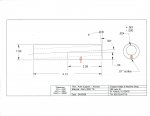Brian Jackson
Platinum Member
- Joined
- Jul 17, 2004
- Messages
- 3,527
- Location
- Hamburg, New Jersey USA
- Aircraft
- GyroBee Variant - Under Construction
In perusing Ralph's GyroBee documentation, I am uncertain from what material the axles are made. I had thought they were steel, and may very well be. If so, can aluminum be substituted? Thanks.


